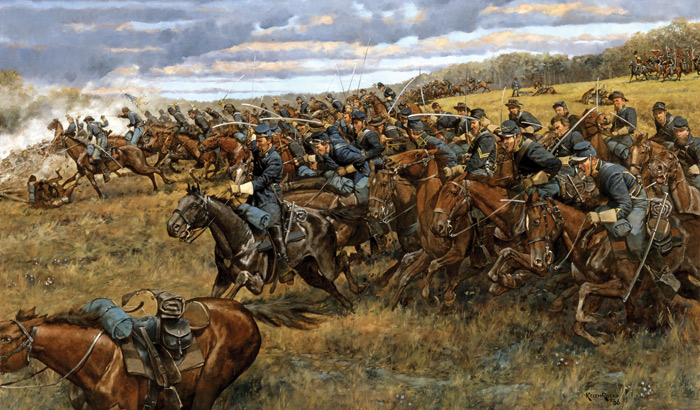On the eve of the 150th anniversary of the Confederate surrender at nearby Appomattox, Longwood University partnered with Appomattox Court House National Park for the 16th annual Civil War Seminar. Longwood, rich in history and tradition, served as a backdrop for the event.
Over three days, Civil War scholars and experts spoke on the final days of the war and the legacy of one of the defining moments of the 19th century. Here are 9 things we learned from the seminar:
1. Generals Lee and Grant had fundamentally different visions of peace.
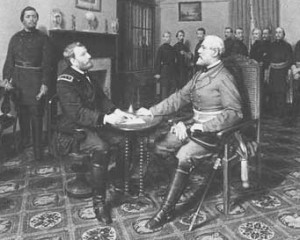 Dr. Elizabeth Varon, an author and professor at the University of Virginia, explained that Gen. Robert E. Lee sought to frame peace as affirmation of Confederate righteousness overwhelmed by military force. For Lee, it was a moral victory in the face of a military defeat. In the years after the war, said Varon, “Lee was not a symbol of submission [to many Southerners] but a symbol of measured defiance.”
Dr. Elizabeth Varon, an author and professor at the University of Virginia, explained that Gen. Robert E. Lee sought to frame peace as affirmation of Confederate righteousness overwhelmed by military force. For Lee, it was a moral victory in the face of a military defeat. In the years after the war, said Varon, “Lee was not a symbol of submission [to many Southerners] but a symbol of measured defiance.”
Conversely, for Gen. Ulysses S. Grant, the surrender at Appomattox was a vindication of the Union–the Northerners had fought and won a moral victory.
2. Frederick Douglass was worried about how Appomattox was being framed.
 “The case that the Confederates sought to build after Appomattox–that they were blameless, that they would not compromise their principles, that they would not yield those principles–had taken root,” said Varon. “And for men like Douglass, that was disturbing.”
“The case that the Confederates sought to build after Appomattox–that they were blameless, that they would not compromise their principles, that they would not yield those principles–had taken root,” said Varon. “And for men like Douglass, that was disturbing.”
Douglass, in 1874, reminded American citizens in the midst of Reconstruction that there was “a right side and a wrong side” in the Civil War, and that the country ought not forget which was which.
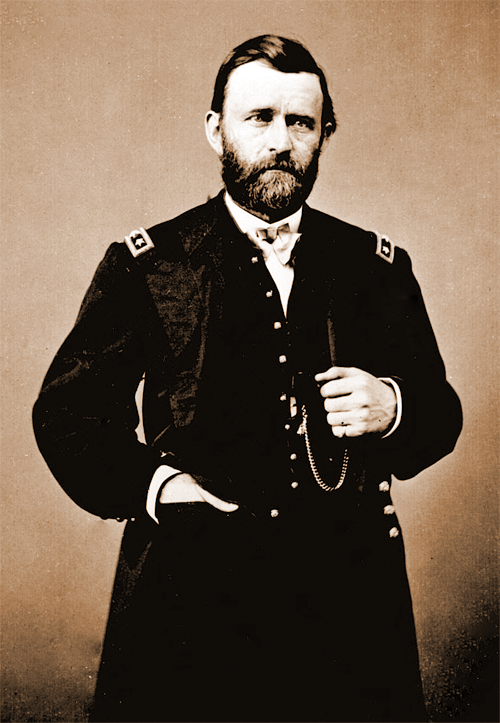 3. The air in the McLean House parlor was thick with Gen. Grant’s cigar smoke.
3. The air in the McLean House parlor was thick with Gen. Grant’s cigar smoke.
“Grant probably smoked during the entire meeting. One of his staff officers said that he consumed 20 cigars a day. We don’t know if he smoked that many or gave them away or chewed on them, but they said that he consumed 20 cigars a day, and there is no doubt that he probably smoked to relieve the tensions of the meeting,” said Ron Wilson, an author and retired historian who worked at several Civil War national parks.
4. A Union soldier, for the second time in the war, had his life literally saved by the Bible.
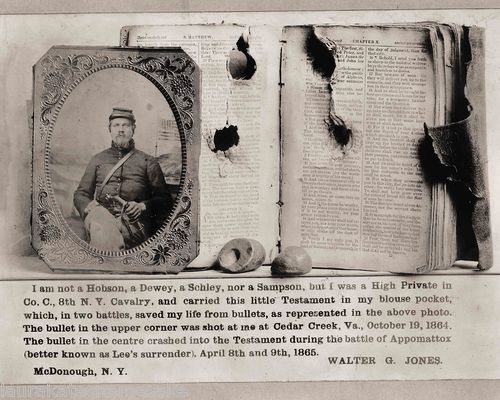 Private Walter G. Jones of the 8th New York Cavalry survived a direct hit when a bullet pierced the Bible in his breast pocket, said Patrick Schroeder, an author and historian at Appomattox Court House National Park.
Private Walter G. Jones of the 8th New York Cavalry survived a direct hit when a bullet pierced the Bible in his breast pocket, said Patrick Schroeder, an author and historian at Appomattox Court House National Park.
The same Bible saved Jones’s life in the Shenandoah Valley in 1864.
5. One Union cavalry unit was known for its unusual battle attire.
“They call them the the Red Neckties because they would wear red neckties under their uniform,” said Schroeder.
6. Horse sense saved the life of one soldier.
In a frantic attempt to escape the approaching Union army, Frank Yates was “struck in the leg with a spent ball.”
Shroeder explained that, unlike a bullet, a spent ball doesn’t pierce the skin–it only numbs the leg. Still, unable to walk, Yates had to make a life-or-death decision in a split second, when he devised a plan that would literally drag him to safety—seizing the tail of the horse that pulled him back to Confederate lines.
“That is a desperate man trying to get away!” Shroeder said.
7. Sailor’s Creek was originally known as Sayler’s Creek.
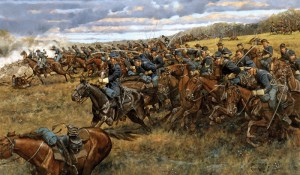 There is a general consensus of confusion when it comes to the spelling of the site of the last major battle of the Appomattox Campaign.
There is a general consensus of confusion when it comes to the spelling of the site of the last major battle of the Appomattox Campaign.
“That’s one of the most asked questions that we hear from visitors,” noted Christopher Calkins, author of The Appomattox Campaign: March 29-April 9, 1865 and a retired park historian.
On a 1750s map of Pennsylvania and Virginia, Calkins noticed the area was spelled Sayler’s Creek. Subsequent maps confirmed this spelling, until Calkins came across the new spelling on a map of Prince Edward County that dated back to 1878. “S-A-I-L-O-R-S is the post-war spelling,” said Calkins.
8. The Battle of Appomattox Station, fought the day before the surrender, was the war’s most unusual battle.
“I tried to find another battle like this in the Civil War, and you can’t do it. It is Confederate artillery against Federal mounted cavalry, mounted cavalry attacking unsupported artillery. It is a very unusual battle,” said Schroeder.
9. What is called the Battle of Sailor’s Creek was actually three battles.
Sailor’s Creek, widely considered the last battle of the Civil War, consisted of separate engagements at the Hillsman Farm, Marshall’s Crossroads and the Lockett Farm (also known as Double Bridges). “The more I studied it, the more I realized it is the Battles of Sailor’s Creek,” said Calkins.
Many of the seminar’s presentations can be watched on C-SPAN.org.
